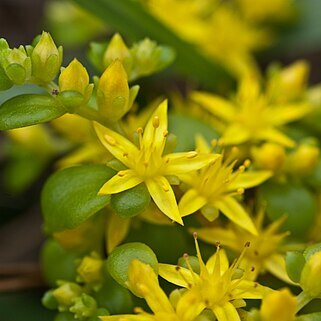Succulent, glabrous, perennial herb, up to 25 cm high. Flowering stems erect from a creeping or procumbent base, once or twice tri-(rarely bi-)furcate, terete, smooth. Leaves alternate, remotely arranged, sessile, very shortly spurred (the spur less than 1 mm), entire, spathulate to broadly obovate, apex round, base long-attenuate, 1.5-3.5 by 0.6-1.6 cm, fleshy, bright green above, paler below, smooth. Inflorescences terminal, a ternate, bracteate, loosely many-flowered cyme. Bracts leafy. Flowers 5-merous, sessile, 6-9 mm at anthesis. Sepals free, very shortly spurred (c. 0.3 mm), entire, spathulate or rarely oblong, apex round, somewhat broadening towards the base, nearly equal in size, 2.8-3.7 by 0.8-1.3 mm, fleshy, ascending at anthesis. Petals bright yellow, basally connate for c. 0.5 mm, lanceolate to oblong-lanceolate, acute, 5.2-6.2 by 1.3-1.6 mm, nearly erect or ascending at anthesis. Stamens 10, shorter than the petal, nearly erect at anthesis; filaments filiform, c. 4.5 mm, the oppositi-petalous ones for c. 0.8 mm connate with the petal, anthers oblong, c. 0.4 mm long, deep yellow before dehiscence. Nectar-scales broadly oblong-obovate to broadly oblong, c. 0.5 by c. 0.4 mm, creamy white, flattish. Gynoecium 5.6-6.2 mm long, the ovaries for c. 1.5 mm connate, ventrally gibbose just above the ventral connection, dorsally round, erect throughout, c. 1.6 mm wide at the middle part, abruptly narrowing near the apex; style 0.9-1.2 mm, slender, tapering towards the apex; stigma lowly papillate, yellowish. Ovules 20-24 in each locule. Follicles 6-7 mm long, whitish, obovate, carpels not spreading. Seeds oblong, c. 0.7 mm long, testa brown, very minutely puncticulate throughout.
More
Herbs perennial. Stems 2-or 3-branched from base, erect, tufted, ± stout, 10-15 cm, densely leafy. Leaves alternate or opposite; leaf blade spatulate, obovate, or suborbicular, ca. 1.5 × 0.8-1.2 cm, apex obtusely rounded. Cyme corymbiform, 5-8 cm in diam., many flowered; bracts leaflike. Flowers sessile, unequally 5-merous, ca. 1 mm in diam. Sepals linear-lanceolate, unequal, 2-3 mm, apex obtuse. Petals yellow, narrowly lanceolate, 6-7 mm, apex sharply pointed. Stamens 10; anthers yellow, shorter than petals. Nectar scales opposite carpels. Carpels broadly lanceolate, 5-6 mm, apex shortly acuminate. Styles ca. 1 mm. Follicles erect, many seeded. Seeds narrowly ellipsoid, ca. 0.4 mm. Fl. Mar-May, fr. Jun-Jul.

